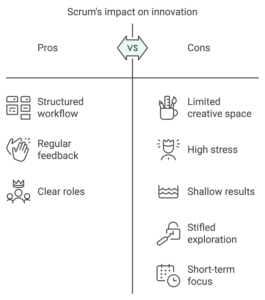Scrum doesn’t truly embody agile principles
The problem with Scrum is that it’s treated as a formulaic solution for “being agile,” but it barely aligns with Agile’s core values. Agile, at its core, is about human interaction and adaptability, putting people over rigid processes. When companies adopt Scrum blindly, they can lose sight of this core principle. They introduce rigid ceremonies and rules that actually get in the way of flexibility, reducing true interaction among team members and limiting the space for innovative problem-solving.
Many who implement Scrum don’t dig into the Agile Manifesto itself. They assume Scrum is the quick path to agility without assessing whether it genuinely serves the team’s needs. This typically leads to a surface-level adoption that misses the point of Agile entirely.
Scrum may not be the right fit: If your goal is to be responsive, adaptable, and genuinely team-centered, a rigid system like Scrum might not be the answer.
Scrum imposes rigid time structures that don’t fit real-world work
In Scrum, sprints impose a strict time frame on every task, regardless of the actual work required. It creates a disconnect between the planned schedule and the natural flow of work. Tasks often don’t fit neatly into two-week sprints, and forcing them to do so can lead to rushed completion or inefficient downtime.
For example, imagine a feature needing three extra days to wrap up; under Scrum, there’s no option to adjust, leaving teams stuck between rushing or leaving it unfinished until the next cycle.
To fit within these time blocks, teams often modify tasks in ways that feel unnatural. They might break down a complex task just to make it fit, resulting in a compromised final product. Real projects aren’t designed to fit arbitrary timeframes, so forcing them to can lead to outcomes that miss the mark, both in quality and effectiveness.
It’s too rigid: The real world demands flexibility, and a rigid sprint structure isn’t built to handle that.
Continuous sprints create unnecessary stress and shallow results
Scrum’s relentless cycle of sprints can lead to a burnout culture. Teams constantly racing to meet sprint deadlines feel the pressure of back-to-back sprints, a pace that encourages short-term thinking over long-term strategy. Teams end up prioritizing speed over quality, delivering quick fixes instead of fully developed solutions.
When you’re always up against a deadline, it’s hard to take a step back and think creatively or strategically.
A narrow focus on short-term goals can make it difficult for teams to see the big picture. Constantly working in small cycles diverts attention from the broader objectives and makes it challenging to align with the larger vision. Scrum’s structure can stifle the kind of exploration and innovation that often requires uninterrupted time.
Creative time is very important: Innovation needs space for creative thinking, and Scrum’s relentless pace leaves little room for it.

Scum’s impact on innovation
Scrum ceremonies and meetings become routine without adding value
Scrum’s ceremonies—daily standups, retrospectives, backlog grooming—quickly becomes a grind. Take daily standups, for example. They’re supposed to keep everyone aligned, but they often feel like a formality, taking time away from actual work without delivering real value. Many team members are relieved when these meetings get canceled or moved to email, as they find them disruptive and repetitive.
Then there are retrospectives, scheduled at the end of each sprint, whether or not there’s anything meaningful to discuss. These forced reflections can end up being nothing more than a routine, where teams “reflect” without new insights or improvements—killing agility by making these meetings mere rituals. Backlog grooming, too, can also feel like a burden.
It lacks responsiveness: Instead of instilling a responsive mindset, Scrum’s recurring ceremonies start to feel like box-ticking exercises that sap time from productive work.
Scrum limits adaptability to change
Scrum’s structure doesn’t leave much room for real-time adjustments. If you’re halfway through a sprint and new information surfaces, Scrum doesn’t provide a way to pivot until the next cycle. It slows down decision-making, and prevents teams from seizing opportunities or avoiding potential issues that emerge mid-sprint.
Agile values responsiveness, but Scrum’s rigidity limits teams from reacting to shifting priorities in real-time. Projects, especially in fast-moving fields, need adaptability. Scrum’s insistence on sticking to a predefined schedule means missing opportunities for immediate adjustments. In dynamic environments, pivoting quickly is a must, and this isn’t something Scrum inherently supports.
Don’t get stuck on the wrong path: Teams end up locked into a set path, even when it’s clear that a different route would be better.
What’s the best alternative approach?
Instead of forcing tasks into fixed sprints, break the work into chunks that align with the needs of the project. These don’t have to fit a predetermined schedule; they can take as much or as little time as they need. This means teams aren’t pressured to finish early or drag out work to meet an arbitrary deadline. Plus, if a task demands multiple hands on deck, this method can easily accommodate that need.
This way of working gives teams the freedom to adjust direction as soon as the situation changes. There’s no waiting until the end of a sprint to pivot; if a new opportunity or requirement arises, teams can shift focus instantly.
Agile is all about responding to change, and this method puts that goal front and center.
Reviews should happen when it makes sense, not according to the calendar. This means holding reviews when the work truly needs feedback, making each session meaningful and productive. Teams get genuine insights from these feedback sessions, not just routine commentary. And if each chunk of work reaches a point where it can be shipped, there’s no need to hold back.
Go for real-world feedback: Iterative delivery means customers and stakeholders can start using the product sooner, with real-time feedback shaping the next phase of development.
Final thoughts
Are you pushing your team through outdated processes that value structure over true adaptability? If your brand’s success relies on innovation, maybe it’s time to rethink these rigid cycles that just keep people busy, not inspired.
What if, instead of sprinting endlessly, your team had the freedom to adjust, explore, and refine in real time—creating solutions that are both on time but are groundbreaking? Does your current approach support real agility, or is it just a habit? It’s worth taking a hard look at what truly drives your team’s best work.





